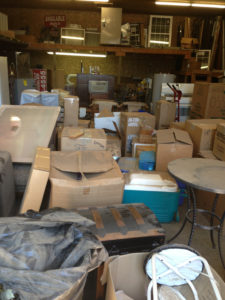It’s time to talk candidly about self-storage. Too many times I hear my clients say, “Let’s just put it into storage.” Sometimes it makes sense, but 99 percent of the time it’s putting off the inevitable with significant cost.
Clearly I have my opinion on this matter. But taking a hard look at the facts associated with long-term storage might convince all of you to rethink storage.
The hard costs of long-term storage
This is an industry fueled by our over-consumption. According to the Self Storage Association, over the last 35 years the self-storage industry has been the fastest growing segment of the domestic commercial real estate industry, generating revenues of more than $22 billion in 2012.

The hard costs of long-term self-storage
Today, there is over 7 square feet of self-storage for every single person in this country. That doesn’t even count the square footage we each take up in our own homes!
Almost 9 percent of American households are renting a self-storage unit – almost a third of which are renting a unit for two or more years. Given that the average cost to rent a 5 ft x 10 ft storage unit is between $35 to $50 a month ($120-$175/month if you rent a climate-controlled unit), that’s over $400 a year just to store your stuff.
What about the hidden costs of storage?
Let’s start with the numbers. Not only do you have to pay to rent the space, you have to also pack up your belongings and get it in and out of the unit.
We recently helped a client move out of a storage unit he had rented for over a year at about $200/month. Working together, we determined he no longer needed the contents of his unit and sold everything for $400. So instead of incurring the $375 expense to move the contents, plus another month’s rent, our client “made” $900.
And those are just the easy costs to track. The longer you keep your stuff in storage, the more likely it is your items will age, discolor and risk damage from the elements (assuming you aren’t renting climate-controlled storage). Too often I’ve seen my clients forget what’s in storage and end up buying the same or similar item to serve an immediate need. Additionally, certain items like accessories, furniture and clothing become outdated the longer they remain in storage.
Adding it up
Considering the hard and hidden costs, does it make fiscal sense for you to keep that dining room set you and your husband bought 30 years ago for $2,000, particularly since it won’t fit into your new home? If your storage need is not temporary, then what is the value of keeping your items minus the cost to store them?
Downsizing is never easy, but often the costs of long-term storage outweigh the value of what is often simple procrastination.
Stay tuned for more dialogue on long-term storage: the emotional expense.